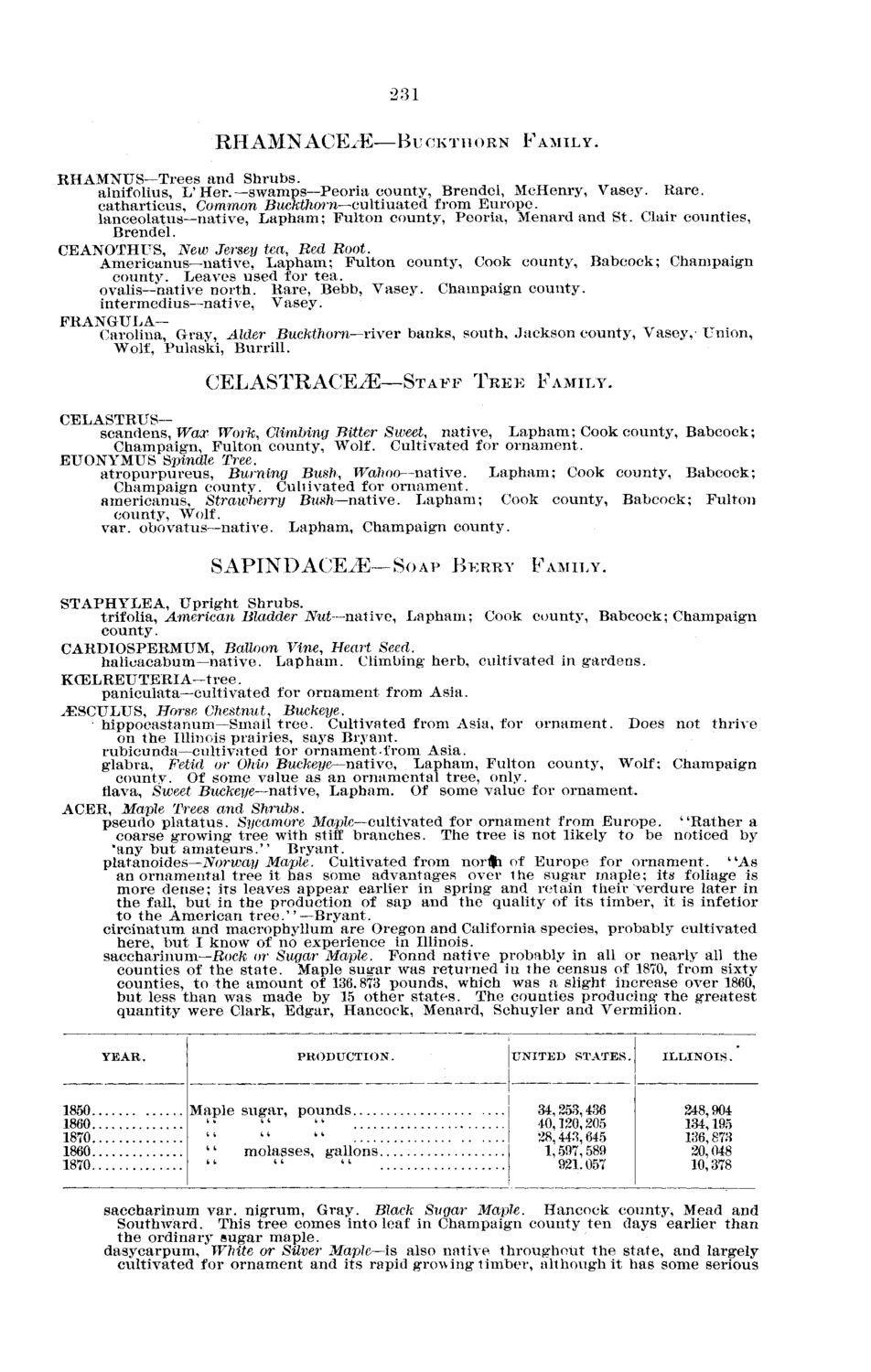| |
| |
Caption: Board of Trustees Minutes - 1878
This is a reduced-resolution page image for fast online browsing.

EXTRACTED TEXT FROM PAGE:
231 R H A M N A C E J E — B U C K T H O R N FAMILY. R H A M N U S - T r e e s and Shrubs. alnifolius, L'Her.—swamps—Peoria county, Brendel, McHenry, Vasey. Rare. catharticus, Common Buckthorn—cultiuated from E u r o p e . lanceolatus—native, L a p h a m ; Fulton county, Peoria, Menard and St. Clair counties, Brendel. CEANOTHUS, New Jersey tea, Bed Boot. Americanus—native, L a p h a m ; F u l t o n county, Cook county, Babcoek; Champaign county. Leaves used for t e a . ovalis—native north. Rare, Bebb, Vasey. Champaign county. intermedius—native, Vasey. FRANGULA— Carolina, Grav, Alder Buckthorn—river banks, south, Jackson county, Vasey, Union, Wolf, Pulaski, Burrill. C E L A S T R A C E ^ E — S T A F F T R E E FAMILY. CELASTRUS— scandens, Wax Work, Climbing Bitter Sweet, native, L a p h a m ; Cook county, Babcoek; Champaign, Fulton county, Wolf. Cultivated for o r n a m e n t . EUONYMUS Swindle Tree. a t r o p u r p u r e u s , Burning Bush, Wahoo—native. L a p h a m ; Cook county, Babcoek; Champaign county. Cultivated for o r n a m e n t , americanus, Strawberry Bush—native. L a p h a m ; Cook county, Babcoek; Fulton county, Wolf, var. obovatus—native. Lapham, Champaign county. S A P I N D A O E ^ - S o A P BERRY FAMILY. STAPHYLEA, Upright Shrubs. trifolia, American Bladder Nut—native, L a p h a m ; Cook county, Babcoek; Champaign county. CARDIOSPERMUM, Balloon Vine, Heart Seed. halicacabum—native. L a p h a m . Climbing herb, cultivated in gardens. KCELREUTERIA—tree. paniculata—cultivated for o r n a m e n t from Asia. ^ S C U L U S , Horse Chestnut, Buckeye. hippocastanum—Small t r e e . Cultivated from Asia, for o r n a m e n t . Does not thrive on t h e Illinois prairies, says Bryant. rubicunda—cultivated t o r ornament-from Asia. glabra, Fetid or Ohio Buckeye—native, Lapham, Fulton county, Wolf; Champaign county. Of some value as a n ornamental tree, only. flava, Sweet Buckeye—native, Lapham. Of some value for ornament. ''Rather a ACER, Maple Trees and Shrubs. noticed by pseudo p l a t a t u s . Sycamore Maple—cultivated for ornament from E u r o p e , coarse growing tree with stiff b r a n c h e s . The t r e e is n o t likely t o be 'any b u t a m a t e u r s . " Bryant. platanoides—Norway Maple. Cultivated from nor1>i of Europe for o r n a m e n t . " A s an o r n a m e n t a l tree it h a s some advantages over t h e sugar maple; its foliage is more dense; its leaves a p p e a r earlier in spring and retain their verdure later in the fall, b u t in t h e production of s a p and t h e quality of its timber, it is infetior to t h e American t r e e . " — B r y a n t . circinatum and macrophyllum a r e Oregon and California species, probably cultivated here, b u t I know of no experience in Illinois. saccharinum—Rock or Sugar Maple. Fonnd native probably in all or nearly all t h e counties of t h e s t a t e . Maple sugar was r e t u r n e d in t h e census of 1870, from sixty counties, t o t h e amount of 136.873 pounds, which was a slight increase over 1860, b u t less t h a n was made by 15 other s t a t e s . T h e counties producing t h e greatest quantity were Clark, Edgar, Hancock, Menard, Schuyler and Vermilion. YEAR. PRODUCTION. UNITED STATES. ILLINOIS. 1850 1860 1870 I860 1870 Maple sugar, pounds 'k molasses, gallons 34,253,436 40,120,205 28,443,645 1,597,589 921.057 248,904 134,195 136,873 20,048 10,378 saccharinum v a r . nigrum, Gray. Black Sugar Maple. Hancock county, Mead and Southward. This t r e e comes into leaf in Champaign county t e n days earlier t h a n the ordinary sugar maple. dasycarpum, White or Silver Maple—is also native throughout t h e state, and largely cultivated for o r n a m e n t and its rapid growing timber, although it h a s some serious
| |